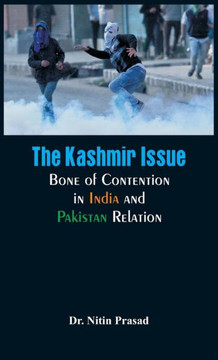
Independently Published
Kashmir, Gujarat, and the Punjab: The Ancient and Modern History of India?s Politically Divided States on the Border with Pakistan
Product Code:
9781792730825
ISBN13:
9781792730825
Condition:
New
$18.94

Kashmir, Gujarat, and the Punjab: The Ancient and Modern History of India?s Politically Divided States on the Border with Pakistan
$18.94
*Includes pictures *Includes online resources and a bibliography for further reading Gujarat is one of the most storied sites in a storied area. Many groups and empires ruled India or tried to, and Gujarat was the power center for the region's oldest of all, the Indus Valley Civilization. Gujarat also played an instrumental role in India's greatest ancient empire. During the last centuries of the first millennium BCE, most of the Mediterranean basin and the Near East were either directly or indirectly under the influence of Hellenism. The Greeks spread their ideas to Egypt, Mesopotamia, and Persia and attempted to unify all of the peoples of those regions under one government. Although some of the Hellenistic kingdoms proved to be powerful in their own rights - especially Ptolemaic Egypt and the Seleucid Empire, which encompassed all of Mesopotamia, most of the Levant, and much of Persia during its height - no single kingdom ever proved to be dominant. The Hellenic kingdoms battled each other for supremacy and even attempted to claim new lands, especially to the east, past the Indus River in lands that the Greeks referred to generally as India. But as the Hellenistic Greeks turned their eyes to the riches of India, a dynasty came to power that put most of the Indian subcontinent under the rule of one king. At less than 20 percent of the population, Indian Muslims would inevitably find themselves overwhelmed by the Hindu majority, and as the British prepared to divest themselves of India, ancient enmities between Hindu and Muslim, long papered over by the secular and remote government of Britain, began once again to surface. At the heart of the geopolitical dispute that resulted is Kashmir, which has often been described as the most beautiful place on earth, but also the most dangerous. Nestled between the Karakoram mountains to the north and the Himalayas to the south, the Vale of Kashmir is a place of mythic beauty, in part the inspiration for James Hilton's Shangri-La, and certainly one of the most unspoiled and lovely regions of South Asia. It also, however, happens to be the fault line of a bitter conflict between two major regional powers, India and Pakistan, who both lay claim its central valley, and its wide and mountainous hinterland. While the conflict between India and Pakistan is multi-faceted, there has always been great division over the Punjab. The word "Punjab" derives from the Persian words "Punj," meaning "five," and "äb," meaning river, combined into the "Land of the Five Rivers." These rivers are the five major tributaries of the River Indus - the Jehlum, the Chenab, the Ravi, the Beas and the Sutlej. They flow southwest off the southern slopes of the Himalayas, meeting the Arabian Sea just south of the modern Pakistani port city of Karachi. This is the valley of the Indus River, the site of some of the oldest and most accomplished civilizations in the world. The Punjab is defined by the floodplains of the five rivers that give the area its name, and as a result, it is one of the most fertile regions of South Asia. However, since the 1947 partition of India, the "Land of Five Rivers" is something of a misnomer, as the partition not only divided India but also the Punjab. The eastern part of Punjab remained a province of India, while the western section was ceded to the newly created Pakistan. As a contiguous region, the Punjab retains its essential character, but now the Indian state of Punjab has only two rivers, the Beas and the Sutlej, and the Pakistani province has the Jhelum, Chenab and Ravi. Kashmir, Gujarat, and the Punjab: The Ancient and Modern History of India's Politically Divided States on the Border with Pakistan examines the various regions, the different civilizations that lived there, and what took place there over the last 5,000 years. Along with pictures and a bibliography, you will learn about Kashmir, Gujarat, and the Punjab like never before.
| Author: Charles River Editors |
| Publisher: Independently published |
| Publication Date: Dec 26, 2018 |
| Number of Pages: 199 pages |
| Language: English |
| Binding: Paperback |
| ISBN-10: 1792730829 |
| ISBN-13: 9781792730825 |





